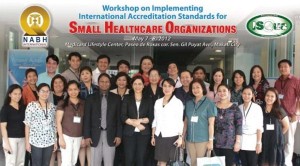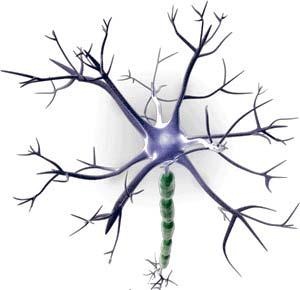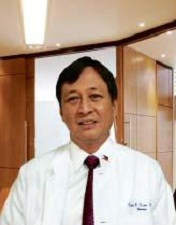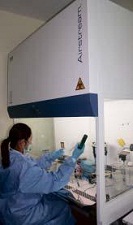PH leads way to stem cell therapy

THE WORKSHOP for Implementing International Accreditation Standards for Small HealthCare Organizations was successfully held last May 7 and 8 at the MediCard Lifestyle Center in Makati City. Shown in photo are NABH International faculties (front row, fourth to sixth from left) Dr. Antony Basile, Dr. Arati Verma and Joyce-Socao-Alumno, executive director of HealthCORE along with the participants: (front row, from left) Cheran Martin (Primarycare Plus), Marinel Solano (MediCard), Mia Boquiron (MediCard), Dr. Elenita Simundac-Daco (Westlake Med. Center), Ma. Veronica Edades (MediCard), Sharry Sta. Ana (MediCard), Jane Fallesgon (MediCard); (second row, from left) Dr. Ma. Olive Lazo (Patient First Med. Center), Dr. Generose Anteojo (Patient First Med. Center), Louise Marie Flores (ANSAP), Marie Therese Pacabis (ANSAP), Maria Linda Buhat (ANSAP) Dr. Gil Yarra (ICOHNS-Davao), Beverly Lozanes (MediCard), Marisciel Santisteban (MediCard), Dr. Catherine Jimenez (MediCard), Ray Intia (MediCard); (third row, from left) Dr. Nicky Montoya (MediCard), Nobell Isabelo (Antipolo Dist. Hospital), Dr. Pascual Pattaui (Taguig Dist. Hospital / St. Therese Multi-Specialty Services), Dr. Basilio Basilio, Jr. (Antipolo Dist. Hospital / St. Therese Multi-Specialty Services), Nilda Silvera (DOH), Dr. Arnel Enriquez (St. Anthony Med. Center), Engr. Roland Atienza (DOH). Not in photo: Lorena Nash (MediCard), Janet Toribio (St. Anthony Med. Center). For the schedule of upcoming workshops, please visit www.healthcore.com.ph.
MANILA, Philippines—In a 1962 experiment, microbiologist Dr. Leonard Hayflick made a grim discovery that human cells grown in tissue culture would only divide a certain number of times, presumably because the telomeres— special DNA sequences found at the tips of chromosomes located within the nucleus of the cells—shorten to a critical length.
In other words, if telomeres become too short to allow cell replication, the cell stops dividing and will ultimately die. This led Hayflick to realize that even if an individual gets through life without contracting a deadly disease or succumbing to a fatal accident, that person will still die when enough of his cells ceased dividing.
This phenomenon now known as the “Hayflick Limit,” sets an unsurpassable lifespan for our species at just over 120 years. Interestingly, this has not discouraged us from trying to challenge the Hayflick Limit, learning new ways to live a healthier life as well as using scientifically proven medication or procedure to fend off diseases or at least keep in check what already ails us. Should the necessity arise, we will not hesitate on getting our damaged tissue or organ “fixed” if not totally replaced so long as we achieve the quality of life we desire. Of course, there are experts and institutions to help us in our quest to enjoy longer, healthier, happier lives—using stem cell based therapy.
New concept
“Stem cell-based therapy is emerging as a new concept for the treatment of various diseases. Owing to the extraordinary advances taking place in the field of cellular and molecular biology, we are slowly moving from just offering mechanical care to biological solutions,” said Dr. Dante Dator, deputy executive director of the National Kidney and Transplant Institute in East Avenue, Quezon City.
The NKTI is a tertiary medical center under the Department of Health which primarily specializes in kidney diseases and organ transplantations. It was the first government hospital in the country to earn an ISO certification and is currently considered as a leader in its field in Asia.
The NKTI, which pioneered stem cell transplantation in the country in 1990 (and has been performing peripheral blood stem cell transplant since 2001), has upgraded and modernized its facilities with equipment at par with those found in the United States: Molecular and Cellular Therapeutics lab, which has already been working on Dendritic Cell Vaccine therapy for cancers (prostate, kidney, breast, lung, liver, colon, gastric, pancreas, cervix, uterine, ovary, myeloma, and lymphoma) together with its sister hospital Lung Center of the Philippines. “A lot of people may not know this, but NKTI’s Stem Cell Transplantation Program has been performing blood and bone marrow transplantation procedures for years and had improved survival for a number of our patients who suffer from diseases like leukemias and lymphomas,” shared Dator.
Faculty capability
 Dator reported that to further strengthen NKTI’s faculty’s capability to match the modernization drive, the hospital has been sending off staff to work with the world’s leading institutions. “The Wake Forest Institute for Regenerative Medicine is a leader in translating scientific discovery into clinical therapies and I had the privilege to work with world-renowned physicians and scientists whose goal is to find a cure, rather than merely to treat a disease.
Dator reported that to further strengthen NKTI’s faculty’s capability to match the modernization drive, the hospital has been sending off staff to work with the world’s leading institutions. “The Wake Forest Institute for Regenerative Medicine is a leader in translating scientific discovery into clinical therapies and I had the privilege to work with world-renowned physicians and scientists whose goal is to find a cure, rather than merely to treat a disease.
The WFIRM was the first in the world to engineer laboratorygrown organs that were successfully implanted into humans and this was the tissueengineered bladder, which was pioneered by Dr. Anthony Atala, the institute’s director and chair of the Department of Urology of Wake Forest School of Medicine,” said Dr. Sigrid Agcaoili of NKTI’s Department of Urology.
Atala had been working to build bladders from patient’s own cells since 1990 and in 1999 implanted the first organ in a patient. In 2006, Atala reported the long-term results in seven children who had the surgery, which showed that the implanted bladders had improved function over time and are durable. She reported that her two- year training at the institute has given her the opportunity to learn the technology of tissue engineering, which involves growing replacement organs and tissues in the lab to replace damaged or diseased tissue.
“This process usually starts with a three-dimensional structure called a scaffold that is used to support cells as they develop. I was involved in a project, which aimed to create an implantable kidney that can restore normal renal function. Shortage of organs for kidney transplantation has been a problem worldwide—the Philippines included. We think that a regenerative medicine approach using patient’s own renal cells seeded onto a kidney scaffold can be an alternative to donor transplantation. In this case, there is no risk of rejection because the cells grew from patient’s own cells,” reported Agcaoili.

DR. SAMUEL Bernal, a worldrenowned Filipino-American cancer specialist and molecular biologist, UCLA Professor Emeritus in Medicine and consultant-adviser to The Medical City’s Regenerative Program at the TMC’s laboratory.
She said this is no longer science fiction considering the skin, blood vessels, bladder, trachea, esophagus, muscle and other types of tissues have been successfully engineered and in fact, been used in treating human diseases.
“Armed with the right training and competent personnel, I believe that we can incorporate regenerative medicine and tissue engineering in the clinical armamentarium for the Filipino patients,” she said. The NKTI is set to collaborate a clinical trial with WFIRM using tissue-engineered bladders for children who have poorly functional urinary bladders (because of a congenital birth defect due to incomplete closure of the spine). “We do hope that with this collaboration, we can give the same value of care to Filipino patients,” hoped Agcaoili. NKTI is currently working on a hybrid project where the dendritic cell will be fused with a viral sector that attacks certain cancers specially head and neck tumors.
No longer impossible
“It is no longer impossible or beyond the realm of possibility that the few of us could now provide the expertise and best services that patients seek. The key word here is ‘personalized molecular medicine.’ We should realize that when it comes to treating patients, no two individuals and no two diseases are the same. Thus, doctors can now select a therapy or treatment protocol based on a patient’s molecular profile that may not only minimize harmful side effects and ensure a more successful outcome, but can also help contain costs compared with a ‘trial-and-error’ approach to disease treatment,” said Dr. Samuel Bernal, a world renowned Filipino-American cancer specialist and molecular biologist, UCLA Professor Emeritus in Medicine and consultant-adviser to The Medical City’s Regenerative Program.
Bernal passionately believes that personalized molecular medicine holds the key to revolutionizing the treatment of diseases such as cancer, diabetes, neurological diseases, diseases of the liver, bones, heart, kidney and other degenerative diseases.
“The field has been spurred in recent years by rapid advances in molecular medicine—such as biochemistry, biophysics, nanotechnology, molecular genetics, molecular immunology,molecular pharmacology, biomaterials, biomedical engineering—new possibilities open up for what can be accomplished. The key to all these developments are our stem cells, which have the ability to become various types of cells or be sensitized to attack diseased cells, including malignant tumors,” he explained. The doctor thanks Dr. Alfredo Bengzon, president and CEO of The Medical City in Pasig for his vision to establish a center of excellence that would provide an end to end solution for stem cell research, clinical research and therapy here in the Philippines.Many years ago, the Philippines already conducted research in regenerative medicine, starting in 1986 when Dr. Alfredo Bengzon was Secretary of Health, and now president and CEO of The Medical City in Pasig.
The Regenerative Medicine Program has been expanded at The Medical City, as part of Dr. Bengzon’s vision to establish a center of excellence in the Philippines that would provide comprehensive range of clinical and laboratory services in molecular and cellular therapeutics, including stem cell therapies, for Filipino and international patients.
But with the Regenerative Medicine Program now established at the The Medical City (with the whole 12th floor devoted to this center), the hospital could now boast as being one of the most advanced in the world, with only a handful of institutions in the United States and Europe that could rival the expertise and services it offers. The Medical City’s Regenerative Medicine Program offers cutting-edge procedures including Stem Cell Transplants wherein infused stem cells harvested from the patient’s bone marrow are processed and “coaxed” to become cells of a specific organ or tissue type and in turn, used to preserve, repair or enhance the functions of the patient’s target organ. Another service offered includes the Dentritic Cell Therapy, wherein the patient body’s own defense system (immune system) is utilized to effectively recognize and destroy cancer cells.

“A LOT of people may not know this, but NKTI’s Stem Cell Transplantation Program has been performing blood and bone marrow transplantation procedures for years and had improved survival for a number of our patients who suffer from diseases like leukemias and lymphomas,” shared NKTI deputy executive director Dr. Dante Dator.
The most effective and safest cells to use for treatments inhumans are human adult cells (especially the natural healing cells from the bone marrow) and human umbilical cord cells, according to Bernal. Human adult and umbilical cord stem cells are also morally, ethically and legally acceptable, unlike embryonic, aborted fetus, genetically altered, and animal stem cells.
Leader
“Many Filipinos may not realize this but the Philippines is now regarded as one of the leaders in regenerative medicine considering that a number of medical institutions here, The Medical City included, have spent not only hundreds of millions of dollars in acquiring the latest and most sophisticated equipment but also in acquiring personnel who trained under the watchful eye of world renowned experts if not pioneers in their respective fields,” Bernal said.
“Many Filipinos may not realize this but the Philippines is now regarded as one of the leaders in regenerative medicine considering that a number of medical institutions here, The Medical City included, have spent not only hundreds of millions of dollars in acquiring the latest and most sophisticated equipment but also in acquiring personnel who trained under the watchful eye of world renowned experts if not pioneers in their respective fields,” Bernal said.
In fact, many patients from foreign countries, such as the US, Europe, Russia and Australia travel to avail of services at The Medical City. Some patients are foreign doctors with serious illnesses who already failed treatments at other medical centers including the US. But why would a foreign patient, say from New York, travel all the way to the Philippines when that person could go to Harvard, Johns Hopkins, Memorial Sloan-Kettering or MD Anderson? At the same time, why would a Filipino seeking the very best care stay here in the Philippines and not fly to the United States?
The answer is Personalized Molecular Medicine—which is very labor intensive, requiring a large number of trained molecular biologists and biochemists who work closely with clinicians in customizing treatment according to the molecular characteristics of the patient’s condition, says Bernal.Aside from being a US Board Certified Internist and Medical Oncologist, Dr. Bernal himself is trained as a chemist and has a Ph.D. in Biochemical Pathology from the University of Chicago, where he worked with several Nobel Prize winners in Medicine and Chemistry.
Later, he was a Principal Investigator in Molecular Medicine at Harvard and UCLA, where he did molecular research and trained many molecular biologists from the US, Europe, Japan and Korea, as well as some scientists from the Philippines who are now working in various Philippine institutions. Dr. Bernal continues to train many biochemists, molecular biologists, and clinical specialists in the US, Europe and in the Philippines, particularly at the Ateneo School of Science and Engineering and the University of Santo Tomas.
Beefing up
Of course, other leading medical institutions in the country are also beefing up their facilities that involved stem cell-based therapy. In line with the 2015 mission of the Makati Medical Center, the hospital recently inaugurated the Cellular Therapeutics Lab (located at the 6th floor of Tower 2) that is set to give hope to those with cancer, diabetes Type 1, neurologic diseases and joints disorders. “Before we could even convince patients, we need to assure them that their cells will be processed by one of the most experienced staff and advanced facilities in the region.We offer ultraclean room facility (class 100) that can handle cell-based products and culture facility; sophisticated procedure to isolate stem cell (magneticactivated cell sorting); meticulous quality control and documentation; high-end equipment that are operated by experienced scientists; and established system to monitor the patient’s progress,” enumerated Dr. Eric Flores, head of MMC Cellular Therapeutics Laboratory.
Ensuring that the more than 170 sq.m. facility is free from biological and non-living contaminants is crucial considering that most of their patients suffers from a weakened immune system. “We put premium importance in the quality and sterility of the product.
Our laboratory is unmatched in terms of providing the best cellular product or quality.
In comparison with other laboratories, the lab is at least three notches better in providing a sterile environment. In fact, the Biosafety Level 5 instituted here is at least one or two notches higher than what is recommended by the US Food and Drug Administration. Moreover, as part of the routine procedure, the facility is continuously monitored for its sterility,” assured Dr. Francis Chung, scientific officer of the Cellular Therapeutics Laboratory’s Stem Cell Lab.
He related that in cases wherein the stem cells will be sourced out from a donor, the MMC Cellular Therapeutics Laboratory has the ability to identify a possible crossmatch— using 10-point DNA matching— for the recipient. “We have the technology to push this cellular transplantation process that will significantly minimize complications,” said Chung.
Stem cell transplant for eyes
In 2006, St. Luke’s Medical Center made history when the hospital’s International
Eye Institute successfully performed a conjuctival stem cell transplant on a 52-yearold
indigent male—harvesting healthy stem cells from his remaining good eye and
then transplanted to his injured eye, replacing the missing cells. Presently, the hospital’s Stem Cell Research and Biotechnology Division is busy doing a lot of work on stem cell-based therapy and at the same time working closely with cardiology, vascular medicine, cancer, neurology, ophthalmology and dermatology department in order to explore and document their experience in their respective field.
Dr. Mark Pierre Dimamay of St. Luke’s Medical Center Stem Cell Research and
Biotechnology Division reported that the hospital has also established collaborations
with leading institutions namely, Singapore’s Eye Research Institute, Korea’s
Hanyang University, United States’ University of Miami, and Germany’s TICEBA (a
highly innovative German life science company, working in the field of stem-cell research and regenerative medicine). Dimamay also shared that the hospital also completed its equipment and requirements for growing human cells.
“The entire process of collecting cells from the patient, processing and growing them can be done at SLMC. We have also applied for the Philippine Food and Drug Administration’s Good Manufacturing Practice certification to ensure that the cells that we generate are made in accordance to international standards. We also acquired a cell-sorting equipment—known as the Clini- MACS—and applied the standard cell culture techniques for growing the stem cells. To develop the technical skills in growing stem cells, we underwent training abroad like Singapore Eye Research Institute for growing ocular stem cells,” he explained.
Dimamay added that being able to grow stem cells and get pure stem cell populations
is helpful in treating a variety of degenerative diseases. “One should realize that adult stem cells are few in number and if these cells can be grown and allowed to multiply in the laboratory, more stem cells can be potentially used for treatment. The cell sorter that we acquired will ensure that the cells being given to the patient are pure stem cells, without any other cellular contaminants.” Dr. Joven Cuanang, St. Luke’s Medical Center (SLMC) chief medical officer and SVP for medical affairs said that the hospital is conducting clinical trials as well as testing to gather evidence and data on a per disease basis to prove if such treatments really work.
Cuanang and Dimamay believe this will increase the credibility of the treatments offered here in the Philippines adding that in the absence of such clinical trials, anyone can offer stem cell therapy at a high premium, and just leave the results of the treatment by chance. “If the treatments don’t work, then the reputation of the institution and even the Philippines would be at stake,” Dimamay explained. (Advt.)















